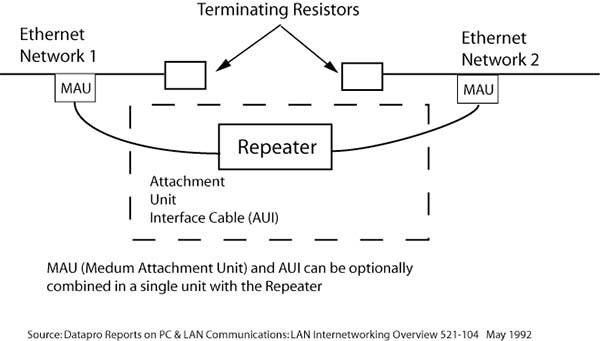Chapter 14 - Internetworking: Emergence 1985-1988
14.2 Repeaters - Physical Layer: Solutions to Extend a Network
If a customer only had Ethernet (CSMA/CD) LANs, and not too many devices connected to them, then the most straightforward solution was repeaters. Repeaters are amplifiers able to boost a decaying LAN signal so it can travel the length of connected LAN(s). Neither complicated nor expensive, repeaters function entirely on the Physical Layer of the OSI Reference Model. (See Exhibit 12.1 The Ethernet Repeater) Their simplicity also gives rise to a fundamental limitation: they boost every signal as if locked in broadcast mode. Thus, all the traffic on one LAN continues onto the next, cumulatively, quickly degrading the performance of the interconnected LANs.
Exhibit 14.2.1 The Ethernet Repeater

Incremental innovation yielded modest repeater improvements, e.g. the ability to detect faults in a connected LAN and isolating the offending LAN. Repeaters, however, could never overcome the limitations inherent in not knowing the source and destination addresses of connected devices. Nor could repeaters ever interconnect different types of LANs, such as Ethernet and token ring. These limitations combined with the compelling economic advantages of interconnecting networks, motivated vendors to take on the more complex, hence expensive, task of innovating the first real product of Internetworking: bridges.3
- [3]:
I was reminded by John Day that the products of Internetworking were not innovated sequentially because they had known from the beginning. What caused the trajectory was the need to master software engineering, and possibly the propensity to pick “low hanging fruit” – my language.